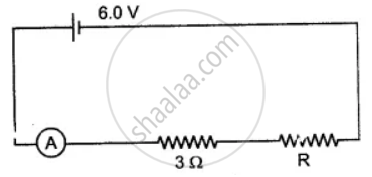Advertisements
Advertisements
Question
Study the following circuit and find:

- Effective resistance of the circuit
- Current drawn from the battery
- Potential difference across the 5 omega resistor
Solution
(i) Effective resistance of the circuit
R3 and R4 are in series and both are parallel to R2
R3 + R4 = 10 Ohm
Effective Resistance across R2 (R')
`1/("R'") = 1/"R"_2 + 1/("R"_3 + "R"_4)`
R' = 5 Ohm
Now, R1', R' and R5 are in series
Effective resistance of the circuit = R1 + R' + R5
= 5 + 5 + 10
= 20 Ohm
(ii) Current drawn from battery
V = IR
I = `"V"/"R"`
I = `20/20`
I = 1 A
(iii) Potential difference across 5-ohm resistor
V = IR
V = 1 × 5
V = 5V
RELATED QUESTIONS
Name a device that help to measure the potential difference across a conductor.
How much energy is transferred by a 12 V Power supply to each coulomb of charge which it moves around a circuit?
100 joules of heat is produced per second in a 4 ohm resistor. What is the potential difference across the resistor?
A current of 0.2 A flows through a wire whose ends are at a potential difference of 15 V. Calculate:
(i) The resistance of the wire, and
(ii) The heat energy produced in 1 minute.
The voltage across a 3Ω resistance is 6 V. How large is the current? What is
the resistance of a filament lamp when a voltage of 3 V across it causes a
current of 0.5 A?
The figure shows a circuit. When the circuit is switched on, the ammeter reads 0.5 A.

(i) Calculate the value of the unknown resistor R.
(ii) Calculate the charge passing through the 3 Ω resistor in 120 s.
(iii) Calculate the power dissipated in the 3 Ω resistor.
State Ohm’s law.
Which of the following represents voltage?
How will you conclude that the same potential difference (voltage) exists across three resistors connected in a parallel arrangement to a battery?
Find the potential difference required to flow a current of 300 mA in a wire of resistance 20 Ω.
